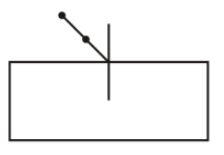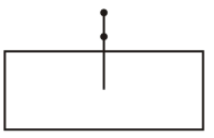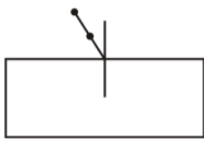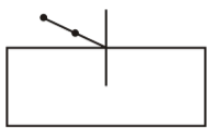
Select from the following the best set-up for tracing the path of a ray of light through a rectangular glass slab:
A.

B.

C.

D.





Answer
553.5k+ views
Hint:First let us see what a glass slab is: Glass slab is a material composed of three-dimensional glass that is shaped like a cuboid. It does not deviate from the sun. This means that both the incident and the emerging ray are parallel. The slab only induces lateral (sideway) moving or displacement.
Complete answer:
Glass slab works on the principle of refraction. As light rays travelling through the air penetrate the glass slab, they are refracted and angled toward the normal. Now the trajectory of the refracted ray shifts again as it comes out of the slab of glass into the air. Since the light ray that I know passes from the denser medium to the rarer medium, it bends away from the normal.
The emergent ray in a rectangular glass slab is parallel to the incidence ray such that the focal length of the glass slab is infinity. Although the power of the lens is reciprocal to the focal length, the power of the glass slab cannot be specified.
The incoming light ray does not be perpendicular to the glass slab since the light emerges straight and the refraction cannot be traced. Therefore, the light rays should not be too close or too far from normal, since it is difficult to track the emerging rays. The perpendicular distance between the original path of the incident ray and the emerging ray is called the lateral displacement.
Hence, option A is the correct answer.
Note:Here we may be confused between option A and C but the ray in option C is a little more far away than option A and the rays should be too far away from the normal.Refraction of light is one of the most commonly observed phenomena, but other waves like sound waves and water waves also experience refraction. Refraction makes it possible for us to have optical instruments such as magnifying glasses, lenses and prisms. It is also because of the refraction of light that we are able to focus light on to our retina.
Complete answer:
Glass slab works on the principle of refraction. As light rays travelling through the air penetrate the glass slab, they are refracted and angled toward the normal. Now the trajectory of the refracted ray shifts again as it comes out of the slab of glass into the air. Since the light ray that I know passes from the denser medium to the rarer medium, it bends away from the normal.
The emergent ray in a rectangular glass slab is parallel to the incidence ray such that the focal length of the glass slab is infinity. Although the power of the lens is reciprocal to the focal length, the power of the glass slab cannot be specified.
The incoming light ray does not be perpendicular to the glass slab since the light emerges straight and the refraction cannot be traced. Therefore, the light rays should not be too close or too far from normal, since it is difficult to track the emerging rays. The perpendicular distance between the original path of the incident ray and the emerging ray is called the lateral displacement.
Hence, option A is the correct answer.
Note:Here we may be confused between option A and C but the ray in option C is a little more far away than option A and the rays should be too far away from the normal.Refraction of light is one of the most commonly observed phenomena, but other waves like sound waves and water waves also experience refraction. Refraction makes it possible for us to have optical instruments such as magnifying glasses, lenses and prisms. It is also because of the refraction of light that we are able to focus light on to our retina.
Recently Updated Pages
Master Class 12 Business Studies: Engaging Questions & Answers for Success

Master Class 12 Economics: Engaging Questions & Answers for Success

Master Class 12 English: Engaging Questions & Answers for Success

Master Class 12 Maths: Engaging Questions & Answers for Success

Master Class 12 Social Science: Engaging Questions & Answers for Success

Master Class 12 Chemistry: Engaging Questions & Answers for Success

Trending doubts
Write a letter to the principal requesting him to grant class 10 english CBSE

Why is there a time difference of about 5 hours between class 10 social science CBSE

What is the median of the first 10 natural numbers class 10 maths CBSE

The Equation xxx + 2 is Satisfied when x is Equal to Class 10 Maths

Discuss the main reasons for poverty in India

10 examples of evaporation in daily life with explanations




